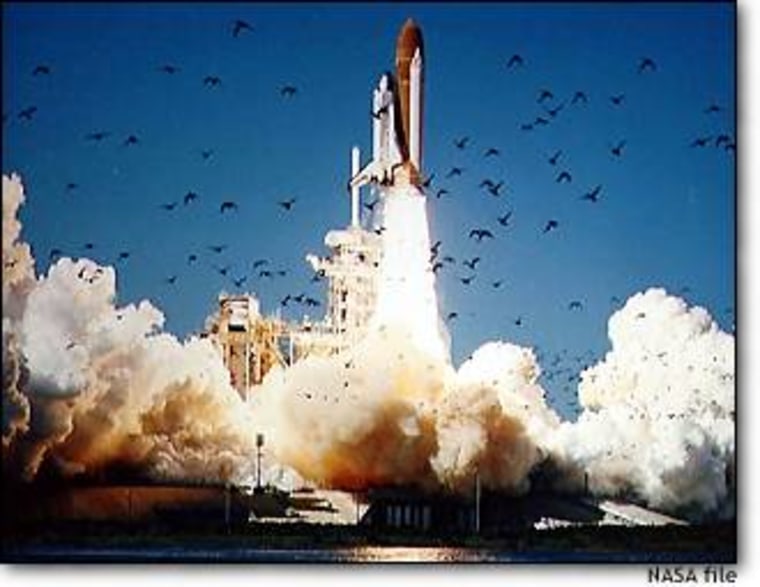In Launch Control, NASA commentator Hugh Harris reported the countdown’s final moments, his words spoken into the microphone as he watched the numbers shining brightly before him.
Green and flashing, the numbers gave him an update with each passing second of the count. A television monitor showed Challenger looming high on its icy launch pad.
But the NASA commentator wasn’t that comfortable relying on electronic vision. He found himself turning often in his seat to peer at the shuttle through the huge glass window behind him, trusting his own eyes to assure that all continued smoothly toward that critical moment of engine ignition.
Hugh Harris had been the “voice of Launch Control” for most of the previous 24 shuttle flights. As chief of information for the Kennedy Space Center, he knew the drill by heart and felt comfortable with the routine to be followed.
Counting down
Last-second events kept the NASA commentator busy, providing a steady stream of information to the outside world. Through the news outlets carrying his running commentary, Harris’ microphone was the public’s link to the event.
“T-minus 10, nine, eight, seven, six, we have main engine start ...”
As the countdown rolled, the astronauts’ families were hurried from their VIP suite to an observation deck on the roof of Launch Control.
From their rooftop location, from the press site, from the VIP stands, ignition began as a flash of coruscating fire.
Challenger came to life.
Searing orange light appeared in a swift rippling of unleashed power. This was the moment of the shuttle’s savage fire birth, the light so intense it forced tears to the thousands of onlookers. Three engine bells, now lost in the controlled tornado of burning rocket fuel, cascaded their violent fire down the curving flame tubes. White clouds snapped into being as fire and water begat shrieking steam. Challenger shook, vibrating its flanks. A blizzard appeared about the huge fuel tank as thunderous vibration ejected the ice storm that had gathered on the flanks of the 15-story-tall external tank.
The main engines screamed in a hoarse bellow, waiting for the computers to sense all three engines were running properly and had built to the required liftoff thrust.
Relays clicked and the computer gave the signal to ignite and release the holding bolts of the two giant solid rocket boosters.
To the onlookers, it appeared as if the sun fell from the sky and writhed wildly at the base of Challenger. Two enormous fire plumes snapped into existence, gushed downward, then spattered away in every direction, raging, uncontainable.
The giant kicked free of the launch pad, spread its flame in a visible punching blast, burning ever brighter, ever fiercer.
Challenger was in climbing free flight.
Hugh Harris’ final countdown came over loudspeakers, on the radio, through the television sets. ” ... four, three, two, one, and LIFTOFF! Liftoff of the twenty-fifth space shuttle mission and it has cleared the tower.” In fact, his words were barely audible over the screams and shouts of thousands of excited onlookers, cries that have been the prayer beseeching success of every astronaut launched. “GO, GO! GO, GO!”
Almost at the same instant Hugh spoke those words, the shock wave from the running engines arrived at the press site and the VIP bleachers three miles distant. The deck trembled, family slammed against family on the roof observation deck. Sound crashed and rolled, tumbling and roaring across the ground and through the air, but at a speed of only 1,000 feet a second, it took 15 seconds before the roar engulfed onlookers.
Inside the crew cabin
Inside the Challenger crew cabin, the seven astronauts felt the spaceship come alive as the three main engines swiveled in a final pre-ignition check and then erupted in fire. Crew Cmdr. Dick Scobee shouted, “There they go, guys!”
“Allll riiight!” came the shout from veteran astronaut Judy Resnik.
“Here we go!” laughed Mike Smith from the pilot’s seat.
As the booster rocket lit off, Challenger leapt from the pad, the sudden acceleration pressing the astronauts back into their seats. The great ship of space thundered skyward on twin columns of fire, trailing an enormous plume of white smoke from the boosters.
The spaceplane lifted higher and higher, bending over into an invisible curving arc toward its destined point in orbit high above the earth. The flame grew longer, mystical, magical, shattering, a howling cyclone of fire longer than the length of two football fields.
Back on the roof deck of the Launch Control building, the families of the seven astronauts, spouses and children stood stunned and awed, their bones vibrating from the thunderous energy of Challenger. Sound engulfed, embraced, crushed them, a sonic juggernaut heralding a magnificent birth.
They reached out to one another, faces wet with tears, and sought each other’s hands. They gripped tightly, unknowingly watching their loved ones leave this Earth.
NBC News correspondent Jay Barbree has covered America’s space effort from Cape Canaveral for more than 40 years. This is an updated version of a series that was first published on MSNBC.com in January 1997.
